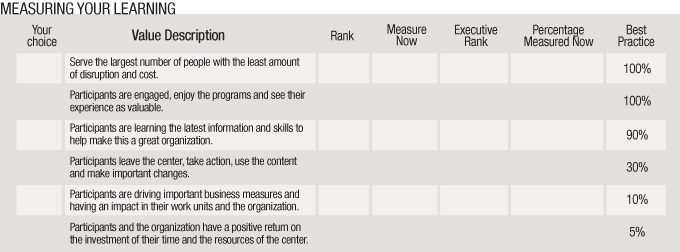Recently we visited the director of learning of a prestigious organization, which had invested in a $75 million refurbishment of the corporate learning facility. The state-of-the-art learning space had breakout rooms for collaborative work teams and a variety of technology-enhanced learning processes. We asked our client, “How will you define success of your new center?” We were a little taken back by his response, which we will reveal at the end of the column.
Learning continues to consume a significant portion of human resources’ budget. Some of the top-tier organizations have learning budgets that approach $1 billion. At the same time, academics and professionals researching learning transfer tell us that more than half of job-related learning is never used. Add to that executives’ desire to see learning connected to business, and this combination creates a mixture of forces that shape how we measure a successful learning center. Let’s conduct a little experiment. Check out the chart.

First, in the box to the left of value description, check the one that is the most important to you. Second, rank each value description in the “Rank” column, including all that apply. Place a number one for the item you consider the most important success measure for your learning function. Continue numbering until the least important measure has the highest number next to it.
In the “Measure Now” column, check the value categories you are measuring. For example, if you count the number of people, time at the center and the costs, check the first item.
It is sometimes helpful to label these value descriptions. The first label is often referred to as Level 0 inputs. These data ensure you cycle many people through the system efficiently. Level 1 is reaction, ensuring that participants react properly to the learning programs. Level 2 is learning, participants acquire knowledge and skills. Level 3 is application, as individuals leave a learning center they take action, using the content. Finally, the next two levels are important: Level 4 is business impact, connecting learning to business measures, and Level 5 is return on investment, which compares monetary benefits to costs.
In the next column, indicate how your executives would rank these data items from one to six, one being the most valuable and six being the least valuable. Executives place the most value in business impact and the least in reaction. In the next column, indicate the percentage of programs measured annually at each level. The best practice profile is in the last column, representing the percentages of programs evaluated at each level each year. Usually the current vs. best practice reveals significant gaps.
Now, back to our opening story. Unfortunately, our client defined success as a facility completely full of people, using all the facilities and rooms (Level 0). Then we asked, “What do you think would be the CEO’s measure of success of this new center?” He thought for a minute and said, “He would probably want to see something connected to the business.” Based on the evidence, that is probably true.
Maybe it is time to rethink how you describe learning and development. Maybe you should be more proactive in moving up the value chain. Just remember: When it comes to showing program value, hope is not a strategy, luck is not a factor, and doing nothing is not an option.















